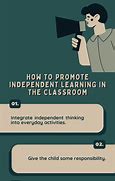What Are The Best Strategies For Encouraging Independent Learning In Children?
In today’s rapidly changing world, it is more important than ever for kids to become self-directed learners. Independent learning is not just about studying alone. It’s about developing a love for learning that stays with a child throughout their life. It is a skill that will help them succeed in school, in their careers, and in life.
The Importance of Independent Learning in Child Development
Independent learning plays a pivotal role in a child’s development, laying a strong foundation for their cognitive, social, and emotional growth. When children are encouraged to take ownership of their learning, they develop critical thinking skills, problem-solving abilities, and a sense of self-reliance. Furthermore, independent learning fosters a love for learning and equips children with the tools to adapt and thrive in an ever-evolving world.
Creating a Supportive Learning Environment
A nurturing and stimulating environment is essential for fostering independent learning. This means creating a space where kids feel safe to explore, experiment, and make mistakes. Here are some key elements to consider:
Setting Up a Dedicated Learning Space:
- Designate a specific area in the home or classroom that is dedicated to learning.
- Stock the space with age-appropriate books, educational games, art supplies, and other materials that encourage exploration.
- Ensure the learning space is well-lit, comfortable, and free from distractions.
Providing Access to Resources:
- Make sure children have access to a variety of resources, including books, magazines, online learning platforms, and educational apps.
- Visit the library regularly to borrow books and other materials, and encourage children to explore different genres and topics.
Encouraging Exploration and Discovery:
- Create opportunities for children to explore their interests.
- Take them on field trips, expose them to new experiences, and encourage them to ask questions.
- Provide them with opportunities to experiment and try new things.
Nurturing Intrinsic Motivation
Intrinsic motivation is the key to sustaining independent learning. When children are genuinely interested in what they are learning, they are more likely to be engaged, persistent, and successful. Here are some strategies to spark and sustain their love of learning:
Connect Learning to Their Interests:
- Encourage kids to pursue their passions.
- If a child is interested in dinosaurs, find books, documentaries, and activities that will expand their knowledge in this area.
Make Learning Fun and Engaging:
- Use games, puzzles, and other hands-on activities to make learning enjoyable.
- Incorporate technology to make learning interactive and exciting.
Provide Positive Reinforcement:
- Praise children for their efforts and accomplishments.
- Celebrate their successes, no matter how small.
Developing Self-Regulation Skills
Independent learners need to be able to manage their time, focus, and emotions effectively. Here are some techniques to help kids develop these essential skills:
Teaching Time Management:
- Help children develop a daily or weekly schedule that includes time for learning.
- Encourage them to break down large tasks into smaller, more manageable steps.
Promoting Focus and Concentration:
- Create a quiet and distraction-free learning environment.
- Use techniques like mindfulness exercises to help children improve their focus.
Building Emotional Intelligence:
- Help kids identify and understand their emotions.
- Teach them strategies for coping with frustration and setbacks.
Cultivating Problem-Solving and Critical Thinking
Critical thinking is essential for independent learning. Encouraging kids to analyze information, think creatively, and come up with solutions on their own will empower them to learn effectively and adapt to new challenges.
Asking Open-Ended Questions:
- Instead of asking simple yes or no questions, encourage kids to think deeply and come up with their own answers.
Encouraging Debates and Discussions:
- Engage children in constructive conversations about different perspectives and ideas.
Presenting Real-World Problems:
- Use real-life scenarios to encourage children to solve problems independently.
The Power of Open-Ended Play and Exploration
Unstructured play is an essential component of independent learning. When kids are free to explore and experiment without adult direction, they develop creativity, problem-solving skills, and a sense of self-reliance.
Providing Opportunities for Imaginative Play:
- Make sure kids have access to toys, games, and materials that encourage creative play.
Creating a Space for Experimentation:
- Allow children to explore their surroundings and engage in hands-on activities that stimulate their curiosity and creativity.
Harnessing Technology for Independent Learning
Technology can be a powerful tool for enhancing independent learning. When used appropriately, technology can open up a world of possibilities for children to explore, learn, and connect with others.
Educational Apps and Websites:
- There are countless educational apps and websites that offer engaging and interactive learning experiences for kids of all ages.
Online Courses and Tutorials:
- Encourage children to explore online courses and tutorials that align with their interests.
Video Conferencing:
- Use video conferencing tools to connect children with mentors, tutors, or other students for collaborative learning experiences.
Encouraging Collaboration and Peer Learning
Collaborative learning can be a powerful way to foster independent thought and communication skills. When children work together, they learn from each other, share ideas, and develop their ability to communicate effectively.
Group Projects and Activities:
- Assign group projects or activities that require children to work together to achieve a common goal.
Peer Tutoring:
- Encourage older students to mentor younger students, or pair children with similar learning styles to help each other.
Setting Clear Expectations and Providing Feedback
Setting clear expectations and providing constructive feedback are essential for guiding children on their independent learning journey.
Establish Clear Goals:
- Work with children to set realistic and achievable goals for their independent learning.
Offer Guidance and Support:
- Provide children with the resources and support they need to achieve their goals.
Provide Constructive Feedback:
- Offer specific and actionable feedback that will help children learn and improve.
Conclusion
Encouraging independent learning in children is a vital step towards their future success. By fostering their natural curiosity, nurturing their self-regulation skills, and providing a supportive environment, we can empower them to become lifelong learners. Independent learners are more likely to be successful in school, in their careers, and in life. They are also more likely to be engaged citizens who are able to contribute to society in meaningful ways.
Frequently Asked Questions
What are some signs that a child is struggling with independent learning?
- They may show a lack of motivation or interest in learning.
- They may have difficulty concentrating or focusing on tasks.
- They may become easily frustrated or discouraged when they encounter challenges.
- They may avoid or resist learning activities.
How can I help my child who is struggling with independent learning?
- Break down tasks into smaller, more manageable steps.
- Offer positive reinforcement and encouragement.
- Create a supportive and encouraging learning environment.
- Work with their teachers or other professionals to develop an individualized learning plan.
What are some resources for parents and educators who want to learn more about independent learning?
- The National Association for the Education of Young Children (NAEYC): https://www.naeyc.org/
- The National Center for Families Learning (NCFL): https://www.familieslearning.org/
- The International Society for Technology in Education (ISTE): https://www.iste.org/

